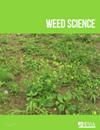Recruitment Biology of Cleavers (Galium spp.) Populations in Western Canada
IF 2.1
2区 农林科学
Q2 AGRONOMY
引用次数: 1
Abstract
Abstract Two species of cleavers, Galium aparine L. and Galium spurium L., are known to inhabit croplands in western Canada. The latter is the more abundant of the two species. An increased abundance of these species over the most recent decades warrants a more comprehensive understanding of their developmental phenology and the cause of this increase. This study aimed to identify the base temperature and emergence characteristics of Galium spp. across different populations from western Canada. A thermal gradient plate experiment was conducted using five G. spurium populations collected from various Saskatchewan (SK) and Alberta (AB) locations. One known G. aparine reference sample was also included. A common garden experiment was conducted using the six Galium spp. populations to determine emergence characteristics. The base germination temperature identified was 2 C for all populations of G. spurium and 4 C for G. aparine. The median germination temperature for G. aparine was 8.34 C, whereas G. spurium had a similar median germination temperature of 6.5 C. Despite similar germination characteristics, the field emergence study revealed differences between populations' initiation of emergence (150 to 250 growing degree days [GDD]) and time to 50% emergence (275 to 470 GDD) in spring. Highly variable emergence among years and populations within the year (200 to 600 GDD in 2013 and 100 to 200 GDD in 2014) were observed during fall, probably due to differences in moisture availability. Cumulative emergence among populations in fall was very low (1% to 9%) compared with spring emergence (2% to 17%). Overall, this study provides evidence for a low base temperature and differences in emergence periodicity among populations, both of which may be significant factors contributing to the seasonal success of this species.加拿大西部Cleaver(Galium spp.)种群的招募生物学
摘要在加拿大西部的农田中发现了两种切花植物,分别是Galium aparine L.和Galium spurium L.。后者是两个物种中数量较多的。近几十年来,这些物种的丰度不断增加,需要对它们的发育物候和这种增加的原因有更全面的了解。本研究旨在确定加拿大西部不同种群镓的基本温度和羽化特征。采用热梯度板实验对从萨斯喀彻温省(SK)和阿尔伯塔省(AB)不同地点采集的5个G. spurium种群进行了研究。还包括一个已知的G. aparine参考样品。以6个居群为研究对象,进行了普通园林试验。所有居群的萌发温度均为2℃,G. aparine居群的萌发温度为4℃。小麦的萌发温度中位数为8.34℃,而小麦的萌发温度中位数为6.5℃。尽管萌发特征相似,但田间出苗研究发现,不同群体在春季萌发起始时间(150 ~ 250生长度日[GDD])和萌发至50%时间(275 ~ 470 GDD)上存在差异。秋季观测到不同年份和种群间(2013年为200 - 600 GDD, 2014年为100 - 200 GDD)的出现变化很大,可能是由于水分有效性的差异。与春季种群的累计出苗率(2% ~ 17%)相比,秋季种群的累计出苗率非常低(1% ~ 9%)。总体而言,本研究为低底温和种群间羽化周期的差异提供了证据,这两者都可能是导致该物种季节性成功的重要因素。
本文章由计算机程序翻译,如有差异,请以英文原文为准。
求助全文
约1分钟内获得全文
求助全文
来源期刊

Weed Science
农林科学-农艺学
CiteScore
4.60
自引率
12.00%
发文量
64
审稿时长
12-24 weeks
期刊介绍:
Weed Science publishes original research and scholarship in the form of peer-reviewed articles focused on fundamental research directly related to all aspects of weed science in agricultural systems. Topics for Weed Science include:
- the biology and ecology of weeds in agricultural, forestry, aquatic, turf, recreational, rights-of-way and other settings, genetics of weeds
- herbicide resistance, chemistry, biochemistry, physiology and molecular action of herbicides and plant growth regulators used to manage undesirable vegetation
- ecology of cropping and other agricultural systems as they relate to weed management
- biological and ecological aspects of weed control tools including biological agents, and herbicide resistant crops
- effect of weed management on soil, air and water.
 求助内容:
求助内容: 应助结果提醒方式:
应助结果提醒方式:


